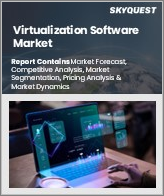
가상화 소프트웨어 세계 시장 규모는 2023년 603억 달러, 2024년 708억 5,000만 달러에서 2032년에는 2,574억 3,000만 달러로 성장하고, 예측 기간중(2025년-2032년) CAGR은 17.5%를 나타낼 전망입니다.
가상화 소프트웨어 시장은 클라우드 컴퓨팅의 확산과 직장에서의 BYOD(Bring Your Own Device) 전략에 대한 수요로 인해 강력한 성장세를 보이고 있습니다. 데스크톱 가상화를 도입함으로써 고용주는 원격 근무자와 사무직 근로자 모두에게 유연성과 보안을 강화할 수 있으며, 다양한 기기와 위치에서 액세스할 수 있는 안전하고 관리되는 데스크톱을 제공할 수 있습니다. 조직은 인프라 최적화, 효율성 향상, 운영 비용 절감을 위해 가상화 기술을 채택하는 사례가 증가하고 있습니다. 하지만 리소스 제약과 데스크톱 용도 프로비저닝의 복잡성 때문에 어려움을 겪고 있습니다. 기술 간의 원활한 통합이 중요하기 때문에 기술 혁신과 관련 비용이 시장 확대에 큰 걸림돌로 작용하고 있습니다.
Global Virtualization Software Market size was valued at USD 60.3 billion in 2023 and is poised to grow from USD 70.85 billion in 2024 to USD 257.43 billion by 2032, growing at a CAGR of 17.5% during the forecast period (2025-2032).
The virtualization software market is experiencing robust growth, primarily driven by the rising adoption of cloud computing and the demand for Bring Your Own Device (BYOD) strategies in workplaces. Implementing desktop virtualization enables employers to enhance flexibility and security for both remote and office workers, offering a secure and managed desktop accessible from various devices and locations. Organizations are increasingly embracing virtualization technologies to optimize infrastructure, improve efficiency, and reduce operational costs, while also mitigating hardware and maintenance expenses by allowing multiple systems to operate on a single physical server. However, resource constraints and the complexities of provisioning desktop applications pose challenges, as seamless integration among technologies is crucial, making innovation and associated costs significant hurdles to market expansion.
Top-down and bottom-up approaches were used to estimate and validate the size of the Global Virtualization Software market and to estimate the size of various other dependent submarkets. The research methodology used to estimate the market size includes the following details: The key players in the market were identified through secondary research, and their market shares in the respective regions were determined through primary and secondary research. This entire procedure includes the study of the annual and financial reports of the top market players and extensive interviews for key insights from industry leaders such as CEOs, VPs, directors, and marketing executives. All percentage shares split, and breakdowns were determined using secondary sources and verified through Primary sources. All possible parameters that affect the markets covered in this research study have been accounted for, viewed in extensive detail, verified through primary research, and analyzed to get the final quantitative and qualitative data.
Global Virtualization Software Market Segments Analysis
Global Virtualization Software Market is segmented by Virtualization Type, Organization Size, Industry Vertical and region. Based on Virtualization Type, the market is segmented into Server Virtualization, Desktop Virtualization, Network Virtualization and Storage Virtualization. Based on Organization Size, the market is segmented into Small and Medium-sized Enterprises (SMEs) and Large Enterprises. Based on Industry Vertical, the market is segmented into IT and Telecom, BFSI, Healthcare, Manufacturing and Retail. Based on region, the market is segmented into North America, Europe, Asia Pacific, Latin America and Middle East & Africa.
Driver of the Global Virtualization Software Market
The swift expansion of remote work has significantly boosted demand within the virtualization software sector, as companies seek effective methods to facilitate remote access to their resources. Desktop virtualization empowers users to securely access organizational information and applications from virtually anywhere, enhancing overall productivity while reducing dependence on physical hardware. This technology ensures that employees enjoy a seamless computing experience, regardless of the device or location they utilize. As a result, firms are increasingly adopting virtualization solutions to meet their remote work challenges and optimize employee efficiency, driving the growth of the global virtualization software market.
Restraints in the Global Virtualization Software Market
Although desktop virtualization offers potential long-term savings, the initial costs can be a significant barrier, particularly for small to medium-sized enterprises. These organizations often encounter substantial expenses related to servers, storage solutions, network bandwidth, and software licensing fees. Furthermore, establishing a virtual desktop infrastructure (VDI) necessitates skilled IT professionals to guarantee proper implementation and ongoing maintenance, which adds to the overall expense. As a result, these financial burdens may dissuade budget-constrained businesses from embracing desktop virtualization solutions, limiting their ability to leverage the benefits of this technology in a competitive market.
Market Trends of the Global Virtualization Software Market
The Global Virtualization Software market is witnessing a significant trend toward cloud-based desktop virtualization solutions, prominently exemplified by the rise of Desktop-as-a-Service (DaaS) offerings from major cloud providers like Microsoft Azure and Amazon Web Services. This shift enables organizations, particularly smaller entities with limited IT resources, to access advanced virtual desktop environments efficiently and cost-effectively. As businesses increasingly prioritize remote work and scalable IT infrastructure, the adoption of flexible DaaS solutions is surging, leading to enhanced productivity, reduced operational costs, and a more agile response to changing market conditions. This trend underscores the vital role of cloud technology in the future of virtualization software.